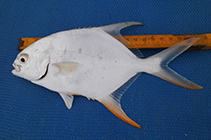| Family: |
Carangidae (Jacks and pompanos), subfamily: Trachinotinae |
| Max. size: |
60 cm TL (male/unsexed) |
| Environment: |
pelagic-neritic; brackish; marine; depth range 0 - 100 m |
| Distribution: |
Eastern Atlantic: west coast of Africa, from Senegal to the Congo estuary (Ref. 57392). |
| Diagnosis: |
Dorsal spines (total): 7-7; Dorsal soft rays (total): 20-23; Anal spines: 3-3; Anal soft rays: 18-21. Diagnosis: body short and deep (its depth 1.8-2.6 times in fork length), lozenge-shaped and strongly compressed; front of head arched; snout rounded; upper jaw extending almost to below hind margin of eye; 11-13 gill rakers on lower limb of first gill arch (Ref. 57392). 2 dorsal fins, 1st with 6 spines, 2nd with 1 spine and 20-23 soft rays; anal fin with 2 short, detached spines followed by 1 spine and 18-21 soft rays (Ref. 57392, 81654). Lobes of soft dorsal and anal fins strongly developed and falcate, longer than head at sizes over 10 cm (Ref. 57392), dorsal fin lobe 1.8-3.2 times in fork length (Ref. 81654). Pectoral fins shorter than head; scales small, cycloid and partially embedded in skin; lateral line scarcely arched over pectoral fins, without scutes (Ref. 57392). 4-6 (usually 5) black spots distributed all along lateral line (in specimens longer than 7-9 cm fork length) (Ref. 57392, 81654).
Coloration: back greenish, sides silvery, with 4-6 (usually 5) dark spots regularly spaced along lateral line, 1st as a vertical line, others oval to circular and becoming progressively smaller backwards; dorsal- and anal-fin lobes dark, caudal fin dark, but light-edged distally; these spots absent or indistinct in juveniles smaller than 100 mm (Ref. 57392). |
| Biology: |
Coastal marine species (Ref. 2683, 57392) occurring down to 100 m depth (Ref. 57392), frequently entering estuaries (Ref. 2683, 57392) and ascending lower courses of rivers (Ref. 57392). Maximum length possibly up to 100 cm (Ref. 57392). |
| IUCN Red List Status: |
Least Concern (LC); Date assessed: 10 May 2013 Ref. (130435)
|
| Threat to humans: |
harmless |
Source and more info: www.fishbase.org. For personal, classroom, and other internal use only. Not for publication.

